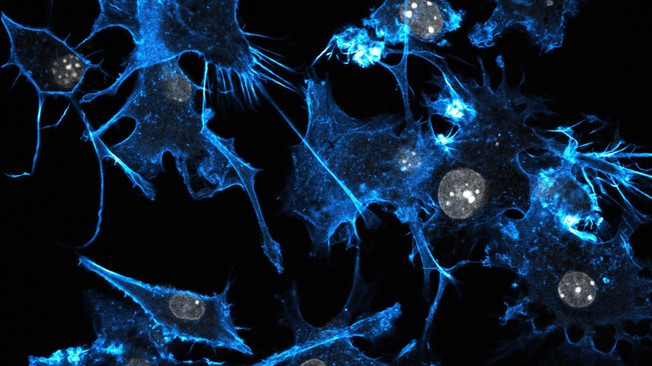Certain immune cells, called CD8 T cells (or cytotoxic T lymphocytes), can recognize and kill melanoma cells, thus have the potential to eradicate the tumor. Immunotherapies stimulate the CD8 T cells to attack the tumor more vigorously. But the activity of CD8 T cells can be suppressed by other immune cells present in the tumor.
Studying a subset of melanoma patients, researchers led by Michele De Palma at EPFL and Daniel Speiser at the University of Lausanne have identified macrophages as culprits driving resistance to a leading immunotherapy, known as PD-1 checkpoint blockade.
“The existence of immune cells that either execute or suppress cytotoxic immune responses is essential for limiting the potentially deleterious effects of an uncontrolled immune response, a condition that may lead to auto-immunity or organ damage,” says De Palma. “The problem is that tumors hijack these regulatory mechanisms to their own benefit, so that they can grow largely unchecked by the immune system”.
By analyzing samples obtained from the patients’ tumors, Speiser and his colleagues found that the CD8 T cells release signals that indirectly attract the macrophages to the tumors, establishing what they refer to as a “dangerous liaison” in melanoma.
“It is a sort of vicious cycle,” says Speiser. “The good side of the coin is that the CD8 T cells get activated by certain tumor antigens and initiate a potentially beneficial immune response against the tumor. The bad side is that, when activated, the CD8 T cells also induce the production of a protein in melanoma, called CSF1, which attracts the macrophages.” Indeed, melanomas that attract many CD8 T cells frequently end up containing many macrophages, which can weaken the efficacy of PD-1 immunotherapy.
Once recruited en masse to the tumor, macrophages suppress the CD8 T cells and dampen the anti-tumoral immune response. But when the scientists used a drug to specifically eliminate the macrophages in experimental models of melanoma, they found that the efficacy of PD-1 checkpoint blockade immunotherapy was greatly improved.
The findings support the clinical testing of agents that disrupt macrophages in combination with PD-1 immunotherapy in patients whose melanomas contain high numbers of both CD8 T cells and macrophages.
“As opposed to targeted therapies that hit specific oncogenes responsible for the growth of the tumor, immunotherapies largely lack biomarkers that can predict whether a patient will respond or not to the treatment”, says De Palma. “Our study suggests that assessing the abundance of macrophages and the contextual presence of CD8 T-cells – for example by measuring genes that are specifically expressed by these cells – may serve to stratify patients who are amenable to more effective immunotherapy combinations,” concludes Speiser.
Contributors
- Ludwig Cancer Research Center and Department of Oncology (University of Lausanne)
- Swiss Institute for Experimental Cancer Research (ISREC, EPFL)
- Yale School of Medicine
- Roche Innovation Center Munich
- Lausanne University Hospital (CHUV)
